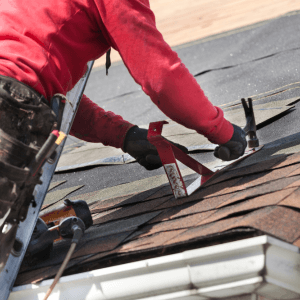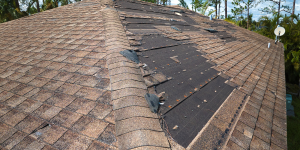When you look at your roof, you probably see the shingles, metal panels, or tiles that make up its outer layer. That’s the part of the roof that gets all the glory—it looks great, protects you from the elements, and lets you sleep soundly during a Texas storm. But there’s one crucial layer under those shingles that you might not know about: roof underlayment.
It may not be glamorous, and you’ll never see it unless you’re on the roof during installation, but it’s a critical part of your roofing system. At Black Hill Roofing, we like to think of underlayment as the unsung hero of a well-protected home. Without it, your roof wouldn’t stand a chance against heavy rain, high winds, or extreme Texas heat. So let’s dive into what roof underlayment is, why you need it, and how it keeps your home safe.
Your Roof’s Secret Weapon: Why Underlayment Matters
Imagine your roof is a rain jacket. The shingles are the outer shell that blocks the rain, but what happens if the shell lets a little water through? That’s where the inner waterproof lining comes into play—that’s your underlayment.
Roof underlayment acts as an added layer of protection between your shingles and your home. Even if your shingles hold up during a storm, wind-driven rain, ice, or debris can still sneak under them. Underlayment is there to stop that water from reaching your roof deck and, ultimately, the inside of your home. Without it, you risk leaks, mold, rot, and costly repairs.
In short: shingles alone aren’t enough. Underlayment has your back when things get rough.
Roof Underlayment 101: The Basics You Need to Know

So, what exactly is roof underlayment? It’s a waterproof or water-resistant material installed directly on your roof deck (the plywood base) before the shingles or other roofing materials go on. Think of it as your roof’s safety net.
There are three main types of underlayment, and each has its own benefits:
- Felt Underlayment (Traditional):
- Made from asphalt-saturated paper, felt is the old-school option.
- It’s affordable and effective, but not as durable as modern alternatives.
- Synthetic Underlayment:
- Made from woven polymers, synthetic underlayment is lightweight, tear-resistant, and waterproof.
- It’s quickly becoming the go-to choice for roofing pros (like us) because it holds up well against Texas heat and storms.
- Rubberized Asphalt Underlayment:
- This premium option offers superior waterproofing thanks to its rubberized texture.
- It’s ideal for high-risk areas like valleys, edges, or under metal roofing.
Which type you choose depends on your budget, roof design, and local weather conditions. Here in Central Texas, synthetic and rubberized underlayment are top picks because they’re durable enough to withstand our heat and sudden storms.
Battling Heat, Rain, and Storms: How Underlayment Helps
Texas weather doesn’t play around. One day it’s 100 degrees, and the next, a thunderstorm rolls in like it owns the place. Your roof is your home’s first line of defense, and underlayment plays a huge role in that.
Here’s how underlayment keeps you covered:
- Protection Against Wind-Driven Rain: During strong storms, rain can get blown under your shingles. Underlayment creates a waterproof barrier to stop leaks.
- Heat Resistance: Texas heat is no joke. High-quality underlayment helps protect your roof deck from damage caused by intense sun exposure.
- Extra Layer of Defense: If a few shingles come loose during a storm, the underlayment will hold the line until repairs can be made.
It’s like having a safety net under a trapeze. You hope you don’t need it, but when you do, you’re glad it’s there.
Is Your Roof at Risk? 5 Signs of Failing Underlayment

Roof underlayment is tough, but it doesn’t last forever. Over time, it can deteriorate, especially if your roof hasn’t been properly maintained. If you notice any of these signs, it could mean your underlayment is compromised:
- Leaks in the Attic or Ceilings: Water stains or drips inside your home often point to underlayment failure.
- Curled or Damaged Shingles: If shingles are out of place, water can seep through to the underlayment.
- Mold or Mildew: Moisture trapped under your roof can lead to mold growth, a sure sign of trouble.
- Sagging Roof Deck: If water gets past the underlayment, it can cause your roof deck to warp or sag.
- Old Age: If your roof is 20+ years old and hasn’t been replaced, the underlayment might be reaching the end of its life.
If you’re seeing any of these red flags, it’s time to give us a call. We’ll check things out and let you know what’s going on up there.
The Costly Consequences of Cutting Corners on Underlayment
Skipping or skimping on roof underlayment might save a little money upfront, but it’s one of those decisions you’ll regret later. Without underlayment, your roof becomes vulnerable to leaks, rot, and structural damage. And once water finds its way in, it doesn’t stop until it reaches your living space.
Here’s the kicker: water damage doesn’t just affect your roof—it can ruin insulation, drywall, and even your home’s foundation. Trust us when we say it’s cheaper to invest in quality underlayment now than to deal with repairs later.
Underlayment Done Right: Why a Pro Makes All the Difference
Choosing the right underlayment is only half the battle. Proper installation is just as important. If underlayment isn’t laid down correctly—like if there are gaps, wrinkles, or overlaps—it won’t do its job.
That’s where we come in. At Black Hill Roofing, we’re big on doing things right the first time. We use top-quality underlayment materials and make sure every inch of your roof is protected. Whether it’s a small repair or a full roof replacement, we treat every project like it’s our own home.
Plus, we know Texas roofs. We understand how to protect homes in Round Rock, Austin, and beyond from the unique challenges of Central Texas weather.
Protect What Matters Most With the Right Underlayment

Your roof might be out of sight, but it should never be out of mind. Roof underlayment is one of those things that works quietly behind the scenes, but its importance can’t be overstated. It’s the layer your roof can’t live without—protecting your home from leaks, storms, and whatever else Texas weather decides to throw at it.
If you’re unsure about the condition of your roof (or its underlayment), don’t leave it to chance. A small problem now can turn into a big, expensive headache later. Give Black Hill Roofing a call, and we’ll take care of the rest.
Schedule a Free Roof Inspection Today!
Ready to make sure your roof is in top shape? Contact us today to schedule a free inspection. We’ll check your underlayment, shingles, and everything in between to make sure your home is safe, dry, and protected for years to come. Because when it comes to your roof, we believe in going the extra mile—so you don’t have to worry.

